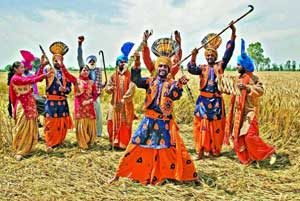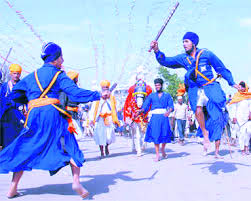| ?BAISAKHI |
 Baisakhi, celebrated with joyous music and dancing, is New Year’s Day in Punjab. It falls on April 13, though once in 36 years it occurs on 14th April. On this day, the tenth Sikh Guru, Guru Gobind Singh, founded the Khalsa (the Sikh brotherhood) in 1699. The Sikhs, therefore, celebrate this festival as a collective birthday. Baisakhi is a typical rural festival that marks the beginning of the solar year, after the lunar month of Baisakh. Farmers rejoice on the day, celebrating the harvest of good crops.
Baisakhi, celebrated with joyous music and dancing, is New Year’s Day in Punjab. It falls on April 13, though once in 36 years it occurs on 14th April. On this day, the tenth Sikh Guru, Guru Gobind Singh, founded the Khalsa (the Sikh brotherhood) in 1699. The Sikhs, therefore, celebrate this festival as a collective birthday. Baisakhi is a typical rural festival that marks the beginning of the solar year, after the lunar month of Baisakh. Farmers rejoice on the day, celebrating the harvest of good crops.
Sikhs visit gurdwaras (Sikh temples) and listen to kirtans (religious songs) and discourses. After the prayer, kada prasad (sweetened semolina) is served to the worshippers. The function concludes with langar, community lunch served by volunteers and processions are taken out mock duels and bands playing religious tunes are part of the processions. School children also enthusiastically take part in them.
For people in villages this festival is the last opportunity for relaxing before they start harvesting corn. Processions and feasts follow the holy scripture of the Sikhs, Guru Granth Sahib.
| HOLA MOHALLA |
 Hola Mohalla is the annual festival of Punjab held at Anandpur Sahib. It was instigated by the tenth Sikh Guru, Gobind Singh, as a gathering of Sikhs for military exercises and mock battles, on the day following the festival of Holi. It teaches them about heroism, courage, and concepts prized by the Tenth Guru, who at that point in time was battling with the Mughal Empire. On this three-day festival, mock battles are held followed by music and poetry competitions. The Nihang Singhs (members of the Sikh army, founded by Guru Govind Singh) carry on the martial tradition with displays of swordsmanship and horse riding. They perform daring feats, such as Gatka (mock encounters), tent pegging, bareback horse riding and standing erect on two speeding horses.
Hola Mohalla is the annual festival of Punjab held at Anandpur Sahib. It was instigated by the tenth Sikh Guru, Gobind Singh, as a gathering of Sikhs for military exercises and mock battles, on the day following the festival of Holi. It teaches them about heroism, courage, and concepts prized by the Tenth Guru, who at that point in time was battling with the Mughal Empire. On this three-day festival, mock battles are held followed by music and poetry competitions. The Nihang Singhs (members of the Sikh army, founded by Guru Govind Singh) carry on the martial tradition with displays of swordsmanship and horse riding. They perform daring feats, such as Gatka (mock encounters), tent pegging, bareback horse riding and standing erect on two speeding horses.
There are a number of durbars relevant to Sri Guru Granth Sahib where Kirtan and religious lectures are also conducted. Fortified with shining swords, long spears and conical turbans, the Nihangs appear fierce as they race on the horseback squirting colors on people.
The last day has a long procession, led by Panj Pyaras, starting from Takth Keshgarh Sahib, one of the five Sikh religious seats, and passing through various important gurdwaras like Qila Anandgarh, Lohgarh Sahib, Mata Jitoji and ending at the Takth.
| ?GURUPURBS |
Gurpurbs are the anniversaries associated with the lives of the Sikh Gurus. The important ones are the birthdays of Guru Nanak along with Guru Govind Singh and the martyrdom days of Guru Arjun Dev and Guru Teg Bahadur.
Guru Nanak, the founder of the Sikh faith, was born in a Punjabi village, in 1469 (now in Pakistan). His birth anniversary, or Guru Nanak Jayanti, which falls in the months of October-November, is ardently celebrated by Sikhs as gurpurab.
Prabhat Pheris is the early morning religious procession that goes around the localities singing shabads (hymns). These Pheris generally start three weeks before the festival. Devotees offer sweets and tea when the procession passes by their home.
The celebrations start with the three-day akhand path in which, the Granth Sahib (the holy book of the Sikhs) is read continuously, from the beginning to the end without a break. The reading concludes, coinciding with the festival day.
The Granth Sahib is carried in procession right through the village or city on this day. It is placed on a van strewn with flowers. Five armed guards, who represent the panj pyares, head the procession carrying Nishan Sahibs (the Sikh flag). Local bands play religious music for the procession. Children of various schools march, as a special part of the procession. Free sweets and Langar are offered to the general public outside some Gurdwaras (Sikh temples).
Sikhs visit gurdwaras where special programmes are arranged and kirtans (religious songs) are sung. Langar or community lunch is also arranged in the gurdwaras. The langar is open to people from all walks of life and of all faiths. Local volunteers serve food with a spirit of seva (service) and bhakti (devotion).
At night, Sikhs decorate their houses and Gurdwaras with candles & electric lights. This festival usually occurs in the month of November (kartik).
The Tenth Guru, Gobind Singh, was born on 2 December 1666 in Patna (Bihar). His Guruship is greatly momentous as he established the distinctive identity of the Sikhs and bestowed the name Khalsa (the pure) to his followers. His birthday, which falls in December, is also marked by prayer readings, kirtans and processions.
The martyrdom day of the fifth Guru, Arjun Dev, is observed with prayers and processions. On this day stalls are put up on the roadsides for offering kachi lassi (sweetened milk) to the thirsty passers-by to pay a tribute to the Guru who was burnt to death during the hot months of May and June.
The ninth Guru, Tegh Bahadur, was put to death in Delhi. His martyrdom day is also observed with prayers and processions. The day occurs in the month of November.
